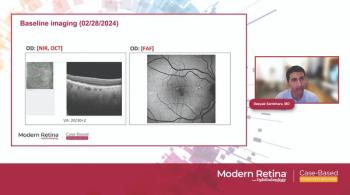
Exploring sirolimus as potential alternative therapy for persistent AMD
Anti-vascular endothelial growth factor (VEGF) therapy is highly successful, but as Raj Maturi, MD, pointed out, also has some limitations.
Anti-vascular endothelial growth factor (VEGF) therapy is highly successful, but as Raj Maturi, MD, pointed out, also has some limitations.
With anti-VEGF therapy, visual acuity deteriorated by more than 2 lines at 5 years after the start of treatment compared with the peak at 2 years. Another challenge is that intraretinal fluid was present in 60% of patients after 5 years, despite treatment, which resulted in worse visual acuity outcomes, he noted.
In addition, some evidence indicates that monthly injections of anti-VEGF drugs increase the development of geographic atrophy, according to Dr. Maturi, who is in private practice, Midwest Eye Institute, Indianapolis.
Dr. Maturi suggested there might be a benefit in discovering alternative treatments.
Sirolimus (also known as rapamycin; DE-109, Santen Pharmaceutical Co.) might be an acceptable alternative, according to Dr. Maturi.
Dr. Maturi and his colleagues previously reported that when sirolimus was compared with standard anti-VEGF treatment for chronic wet age-related macular degeneration in 40 eyes, the 20 patients randomly assigned to treatment with 3 injections of sirolimus administered every other month experienced a significant (p = 0.049) decrease in central subfield thickening compared with the 20 patients treated with 6 monthly injections of anti-VEGF therapy.
The decreases in the central subfield thicknesses were 30 μm and 7.5 μm, respectively. The decrease in the subretinal fluid at 6 months was also significantly in favor of sirolimus.
Dr. Maturi and colleagues then conducted the study under discussion-a 36-week prospective, subject-masked, randomized trial-to determine if adding aflibercept (Eylea, Regeneron Pharmaceuticals) to treatment with sirolimus (combination treatment) might be superior to the anti-VEGF treatment alone (comparative arm).
The 10 patients in the combination arm received sirolimus at baseline, week 4, and then every 8 weeks, and the aflibercept was administered every 8 weeks. The 10 patients in the comparative arm were treated with aflibercept every 8 weeks. Patients were included if they had significant intraretinal fluid and activity despite multiple previous treatments. Visual acuity levels in the two groups were similar.
The most important change found in the study, according to Dr. Maturi, was the effect on the central subfield thickness.
“We found that at week 1 there was a slight decrease in the central subfield thickness in the combination group, and the comparative group had a greater decrease of about 40 μm,” he said. “However, at the 1-week time point, the patients in the combination group were treated with aflibercept, and the decrease in the central subfield thickness increased to about 80 μm.”
It is noteworthy that these patients had been previously treated with numerous drugs but still experienced a significant improvement with the combination treatment.
“This improvement seemed to last with the combination treatment,” Dr. Maturi said. “The difference from baseline in the central subfield at week 12 was significant. However, the endpoint at week 36 was not significant.”
Evaluation of the central 1-mm foveal volume showed similar results. Both groups had decreases in the subretinal fluid volume. At week 36, there was almost no intraretinal fluid present in the combination group, according to Dr. Maturi.
He demonstrated on optical coherence tomography scans the decreases in subretinal fluid that occurred in the combination therapy group. Seven-slice scans obtained at week 36 showed the decreases in all of the parameters evaluated. These patients had previously been treated with from 60 to 70 or more anti-VEGF drug injections over the course of their therapy and had had no substantial improvements.
“Sirolimus has a biologic effect on choroidal neovascularization,” Dr. Maturi said. “The drug appears to be safe when the injections are administered 4 weeks apart as opposed to a loading dose and also when administered with anti-VEGF therapy.
“This study did not meet its primary endpoint, which I believe was likely the result of the small sample size,” he said.
The changes in best-corrected visual acuity were similar for both groups.
“We might have found a better gain in visual acuity in the less-diseased eye,” Dr. Maturi said. “The combination treatment virtually eliminated the intraretinal fluid, which seems to be correlated with poor visual acuity.”
Dr. Maturi is a consultant for Santen. He spoke at the 2017 meeting of the American Society of Retina Specialists in Boston.
Newsletter
Keep your retina practice on the forefront—subscribe for expert analysis and emerging trends in retinal disease management.










































